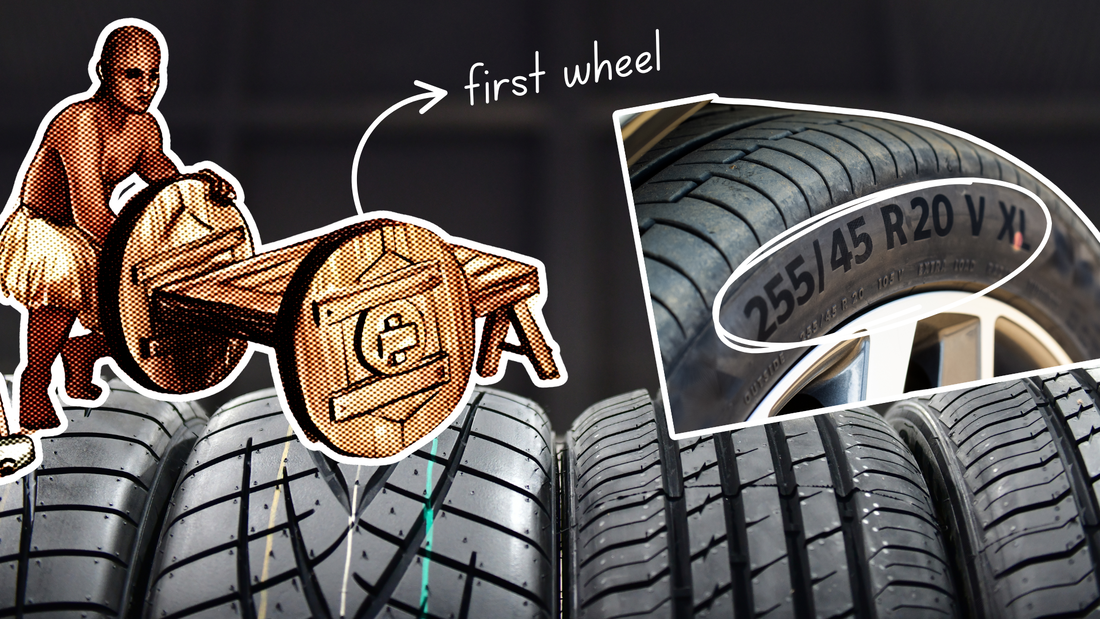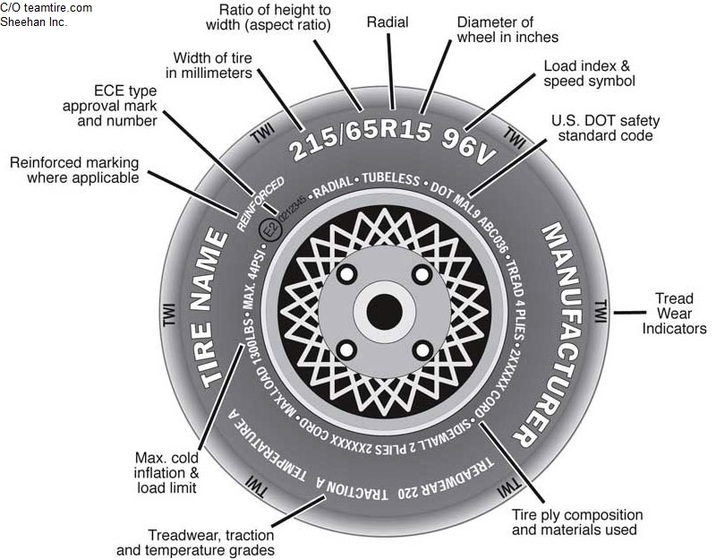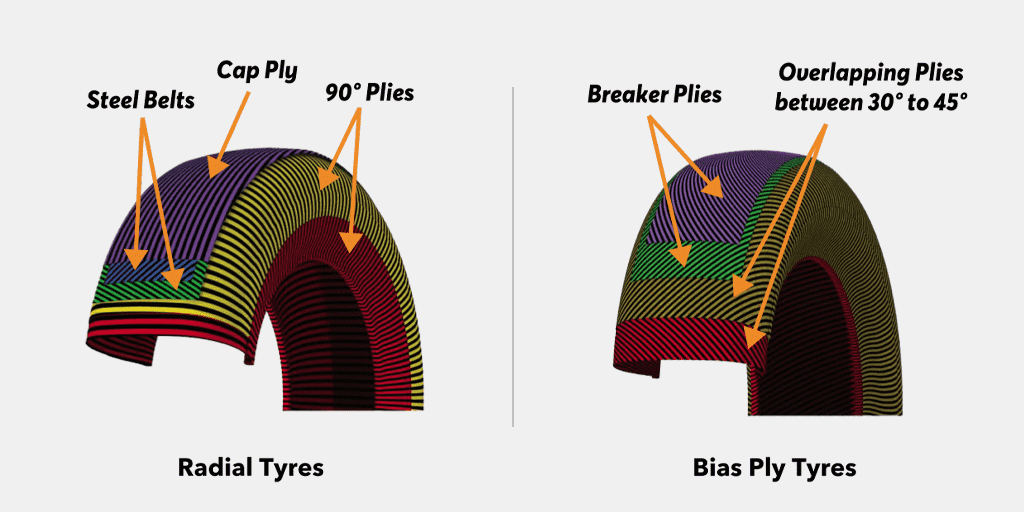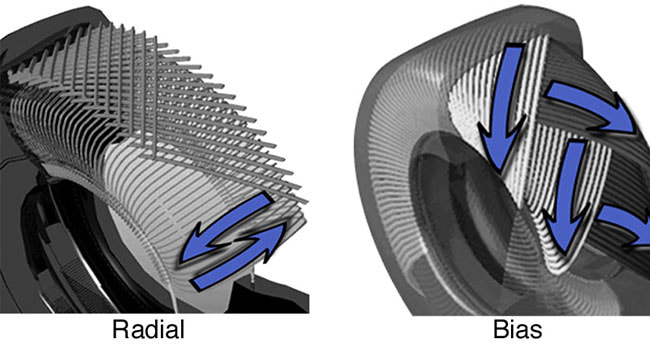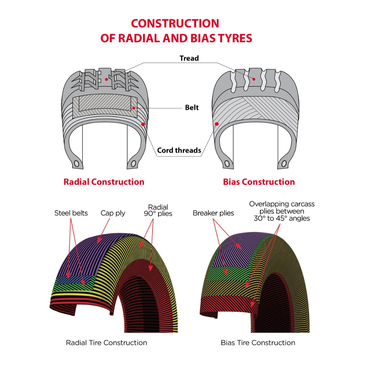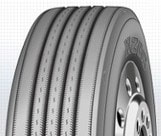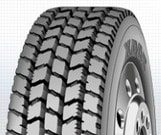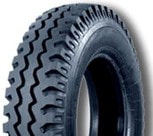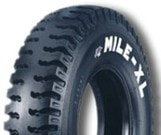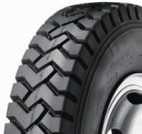TIRE MUST KNOW
Introduction
Tire Identification
Tire Code
Tire Construction
Tread Pattern
Tire Services
See also: More on Tires, Caring for Tires
Tire Identification
Tire Code
Tire Construction
Tread Pattern
Tire Services
See also: More on Tires, Caring for Tires
TIRES top
The invention of the wheel by the Sumerians around 3500 B.C. marked one of humanity’s greatest advancements in transportation. However, the wheel itself underwent centuries of innovation before becoming the modern tire we rely on today. The most significant breakthrough came from Charles Goodyear, who, despite falling into lifelong debt, discovered the process of vulcanization—a method that made rubber durable and heat-resistant. His work laid the foundation for the tires we use today. Sadly, Goodyear never saw the fruits of his labor, as mass production of tires began 15 years after his death, spearheaded by John Dunlop in the 1880s, who introduced the pneumatic (air-filled) tire.
A tire is a ring-shaped covering designed to fit around a wheel rim, serving a critical role in vehicle performance. It provides traction, stability, and shock absorption, ensuring a smooth and controlled ride. By maintaining close contact with the ground, tires improve safety, fuel efficiency, and handling. Modern tires are constructed from a blend of synthetic and natural rubber, fabric, steel wire, and chemical compounds, each carefully engineered to enhance durability, grip, and overall performance. From ancient wooden wheels to today’s high-tech, all-terrain tires, this essential invention continues to evolve, shaping the way we move across the world.
A tire is a ring-shaped covering designed to fit around a wheel rim, serving a critical role in vehicle performance. It provides traction, stability, and shock absorption, ensuring a smooth and controlled ride. By maintaining close contact with the ground, tires improve safety, fuel efficiency, and handling. Modern tires are constructed from a blend of synthetic and natural rubber, fabric, steel wire, and chemical compounds, each carefully engineered to enhance durability, grip, and overall performance. From ancient wooden wheels to today’s high-tech, all-terrain tires, this essential invention continues to evolve, shaping the way we move across the world.
- Tube – The inner tube is a flexible, airtight rubber casing that holds the air inside tube-type tires. It maintains air pressure and provides cushioning, ensuring a smooth ride. Tubes are commonly used in heavy-duty vehicles, motorcycles, and bicycles.
- Flap – A protective rubber lining placed between the tube and the rim, the flap prevents direct contact with the metal rim and shields the tube from damage caused by friction or sharp edges. It helps extend the life of the tube by reducing wear and tear.
- Rim – The metal wheel structure that supports the tire, the rim provides a secure mounting surface for both tube-type and tubeless tires. It plays a vital role in maintaining tire shape, ensuring stability, and enhancing vehicle handling. Different rim sizes and designs are used based on vehicle type and intended application.
IDENTIFY YOUR TIRE top
Tires have a lot of labels around it. See the image below for what those labels stand for.
TIRE CODE top
| METRICS for LT215/65R15 8P 96V RIB | |
| Category | Description |
| Vehicle Class (LT) | Could be Light Truck (LT), Passenger (P), Special Trailer (ST), or Temporary/Spare (T). |
| Width of Tire (215) | Width of the tire cross-section in millimeters. Some tires may omit this, typically having a sidewall ratio of 80-100%. |
| Ratio of Height to Width (65) | Sidewall height, measured as a percentage of the width. In this case, 65% of 215mm = 139.75mm. Often omitted for cargo-type tires (e.g., 185R14, 195R15). |
| Construction (R) | Could be Radial (R) or Bias (B). |
| - Bias: Cheaper, puncture-resistant, easy to repair. | |
| - Radial: Longer lifespan, better stability, shock absorption. | |
| Rim Diameter (15) | Indicates the rim size (in inches) that the tire fits. |
| Ply Rating (8P) | Number of nylon belts around the tire, indicating its load-carrying capacity. |
| Load Index (96) | Represents the maximum load each tire can carry. (96 = 710kg per tire). |
| Speed Symbol (V) | Indicates the maximum speed the tire can handle at full load. (V = 240 km/h). |
| Tread Pattern (RIB) | Can be RIB, Block, RIB-LUG, or LUG. |
| - RIB: Best for high-speed paved roads. | |
| - LUG: Best for off-road and industrial work. | |
| METRICS for LT215/65R15 8P 96V RIB | |
| METRICS for 30.5X7.50R16 16P | |
| Category | Description |
| Tire Diameter (30.5) | Diameter of the tire in inches. Usually 1 inch larger when fully inflated. May be omitted in some tires, with sidewall ratio typically 80-100%. |
| Width of Tire (7.50) | Width of the tire cross-section in inches. Usually 1-2 inches wider when fully inflated. May be omitted for cargo-type tires (e.g., 750-16, 1000-20). |
| Nylon or Bias (R) | A dash (-) represents bias-ply tires, while R indicates radial tires. |
| Rim Diameter (16) | Fits a rim with the given diameter (in inches). |
| Ply Rating (16P) | Number of nylon belts around the tire, indicating its load-carrying capacity. |
| METRICS for 30.5X7.50R16 16P | |
TIRE CONSTRUCTION top
| TIRE CONSTRUCTION TABLE | |||
| Radial | Characteristic | Advantage | Bias |
| Radial tires have additional support on the tread wall which is separate from the side wall. | Overload | Bias | Bias tires have the same supports on its sidewall and tread wall. |
| Product Life | Radial | ||
| Price | Bias | ||
| Shock Absorption | Radial | ||
| Friction | Radial | ||
| Brake Power | Radial | ||
| Stability | Bias | ||
| Off-road Driving | Bias | ||
| Repair Costs | Bias | ||
| TIRE CONSTRUCTION TABLE | |||
This illustration shows the drive handling and construction difference of bias and radial tires. Bias tires are like leather shoes, it can withstand more pressure, heavier load, worse terrain and worse weather. Bias tires also require less care for drivers and less maintenance between trips. Radial tires are like rubber shoes, it gives additional comfort, better control, longer lifespan and better driving. But, radial tires will require additional care and maintenance for you to get the most out of the tire.
PASSENGER VEHICLE TIRE TREAD PATTERN top
DIRECTIONAL
It has large V-shaped pattern across the tire, best for highway drives. It gives better straight drive acceleration and grip, the grooves give better hydroplaning for rainy weather.
It has large V-shaped pattern across the tire, best for highway drives. It gives better straight drive acceleration and grip, the grooves give better hydroplaning for rainy weather.
SYMMETRICAL
It has independent lugs across the whole tire, best for city drives. It gives better grip when turning a corner and when braked on an inclined surface.
It has independent lugs across the whole tire, best for city drives. It gives better grip when turning a corner and when braked on an inclined surface.
JACK OF ALL TRADES
It has the features of directional, symmetrical and asymmetrical. It will do fine on any road and traffic conditions.
It has the features of directional, symmetrical and asymmetrical. It will do fine on any road and traffic conditions.
ASYMMETRICAL
It has lugs and patterns that will grip on any direction, Suited for racing. The tire provides maximum grip on any kind of surface under and kind of weather, usually reinforced with thicker side walls for better stability, braking and acceleration.
It has lugs and patterns that will grip on any direction, Suited for racing. The tire provides maximum grip on any kind of surface under and kind of weather, usually reinforced with thicker side walls for better stability, braking and acceleration.
ALL TERRAIN
It has the features of an asymmetric tire but has deeper tread, suited for mild off-road terrain and will still perform well on paved roads. The tread is for better grip for wet of road conditions and avoid punctures from stones and wood barks.
It has the features of an asymmetric tire but has deeper tread, suited for mild off-road terrain and will still perform well on paved roads. The tread is for better grip for wet of road conditions and avoid punctures from stones and wood barks.
MUD TERRAIN
It has features similar to heavy equipment mining tires, suited for driving on off road terrain. The deep tread will ensure the tires will grip on very uneven wet surfaces, and ensure safety when driving across rocky terrain.
It has features similar to heavy equipment mining tires, suited for driving on off road terrain. The deep tread will ensure the tires will grip on very uneven wet surfaces, and ensure safety when driving across rocky terrain.
TRUCK TIRE TREAD PATTERN top
RIB is the smoothest, thus gives less noise and more speed. Parallel treads prevent skidding. Best for paved roads.
BLOCK is rougher than RIB, thus giving more power to brakes and improving stability at the expense of speed, noise and longevity. Best for cemented roads.
RIB-LUG combines RIB with the stability of LUG on off-roads. This comes at the expense of speed, noise and longevity. Good for on-road and off-road at low speeds (>60kph) .
LUG is made for the industry, because it provides the best stability at very low speeds (>30kph). Best for unpaved roads and off-roads.
MINING is made for the mountains, because it provides the best grip and stability at the worst kind of terrain. Best for off-roads.
